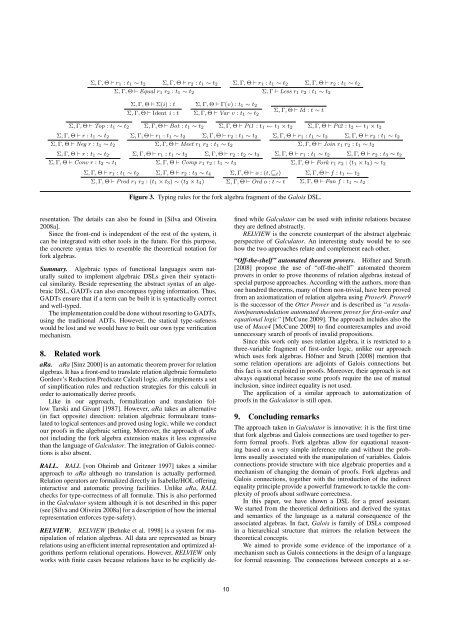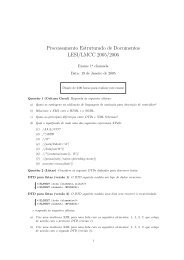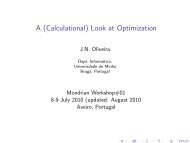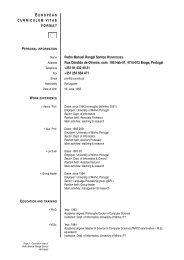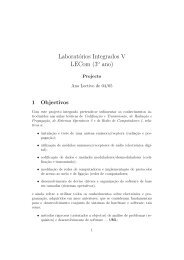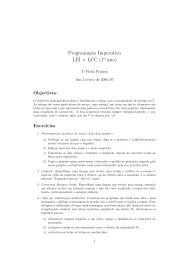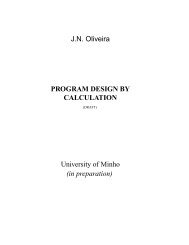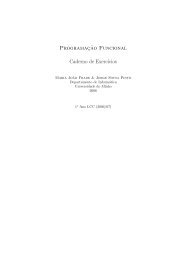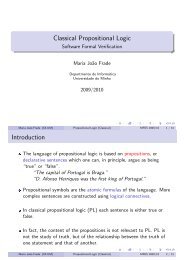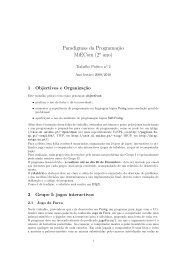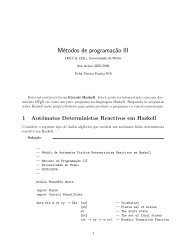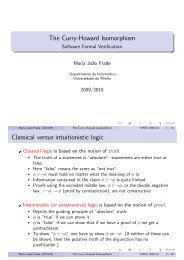Galois
Galois
Galois
You also want an ePaper? Increase the reach of your titles
YUMPU automatically turns print PDFs into web optimized ePapers that Google loves.
Σ, Γ, Θ ⊢ r 1 : t 1 ∼ t 2 Σ, Γ, Θ ⊢ r 2 : t 1 ∼ t 2<br />
Σ, Γ, Θ ⊢ Equal r 1 r 2 : t 1 ∼ t 2<br />
Σ, Γ, Θ ⊢ r 1 : t 1 ∼ t 2 Σ, Γ, Θ ⊢ r 2 : t 1 ∼ t 2<br />
Σ, Γ ⊢ Less r 1 r 2 : t 1 ∼ t 2<br />
Σ, Γ, Θ ⊢ Σ(i) : t<br />
Σ, Γ, Θ ⊢ Ident i : t<br />
Σ, Γ, Θ ⊢ Γ(v) : t 1 ∼ t 2<br />
Σ, Γ, Θ ⊢ Var v : t 1 ∼ t 2<br />
Σ, Γ, Θ ⊢ Id : t ∼ t<br />
Σ, Γ, Θ ⊢ Top : t 1 ∼ t 2 Σ, Γ, Θ ⊢ Bot : t 1 ∼ t 2 Σ, Γ, Θ ⊢ Pi1 : t 1 ← t 1 × t 2 Σ, Γ, Θ ⊢ Pi2 : t 2 ← t 1 × t 2<br />
Σ, Γ, Θ ⊢ r : t 1 ∼ t 2 Σ, Γ, Θ ⊢ r 1 : t 1 ∼ t 2 Σ, Γ, Θ ⊢ r 2 : t 1 ∼ t 2 Σ, Γ, Θ ⊢ r 1 : t 1 ∼ t 2 Σ, Γ, Θ ⊢ r 2 : t 1 ∼ t 2<br />
Σ, Γ, Θ ⊢ Neg r : t 1 ∼ t 2 Σ, Γ, Θ ⊢ Meet r 1 r 2 : t 1 ∼ t 2 Σ, Γ, Θ ⊢ Join r 1 r 2 : t 1 ∼ t 2<br />
Σ, Γ, Θ ⊢ r : t 1 ∼ t 2 Σ, Γ, Θ ⊢ r 1 : t 1 ∼ t 2 Σ, Γ, Θ ⊢ r 2 : t 2 ∼ t 3 Σ, Γ, Θ ⊢ r 1 : t 1 ∼ t 2 Σ, Γ, Θ ⊢ r 2 : t 3 ∼ t 2<br />
Σ, Γ, Θ ⊢ Conv r : t 2 ∼ t 1 Σ, Γ, Θ ⊢ Comp r 1 r 2 : t 1 ∼ t 3 Σ, Γ, Θ ⊢ Fork r 1 r 2 : (t 1 × t 3 ) ∼ t 2<br />
Σ, Γ, Θ ⊢ r 1 : t 1 ∼ t 2 Σ, Γ, Θ ⊢ r 2 : t 3 ∼ t 4<br />
Σ, Γ, Θ ⊢ Prod r 1 r 2 : (t 1 × t 3 ) ∼ (t 2 × t 4 )<br />
Σ, Γ, Θ ⊢ o : (t, ⊑ t)<br />
Σ, Γ, Θ ⊢ Ord o : t ∼ t<br />
Figure 3. Typing rules for the fork algebra fragment of the <strong>Galois</strong> DSL.<br />
Σ, Γ, Θ ⊢ f : t 1 ← t 2<br />
Σ, Γ, Θ ⊢ Fun f : t 1 ∼ t 2<br />
resentation. The details can also be found in [Silva and Oliveira<br />
2008a].<br />
Since the front-end is independent of the rest of the system, it<br />
can be integrated with other tools in the future. For this purpose,<br />
the concrete syntax tries to resemble the theoretical notation for<br />
fork algebras.<br />
Summary. Algebraic types of functional languages seem naturally<br />
suited to implement algebraic DSLs given their syntactical<br />
similarity. Beside representing the abstract syntax of an algebraic<br />
DSL, GADTs can also encompass typing information. Thus,<br />
GADTs ensure that if a term can be built it is syntactically correct<br />
and well-typed.<br />
The implementation could be done without resorting to GADTs,<br />
using the traditional ADTs. However, the statical type-safeness<br />
would be lost and we would have to built our own type verification<br />
mechanism.<br />
8. Related work<br />
aRa. aRa [Sinz 2000] is an automatic theorem prover for relation<br />
algebras. It has a front-end to translate relation algebraic formulæto<br />
Gordeev’s Reduction Predicate Calculi logic. aRa implements a set<br />
of simplification rules and reduction strategies for this calculi in<br />
order to automatically derive proofs.<br />
Like in our approach, formalization and translation follow<br />
Tarski and Givant [1987]. However, aRa takes an alternative<br />
(in fact opposite) direction: relation algebraic formulæare translated<br />
to logical sentences and proved using logic, while we conduct<br />
our proofs in the algebraic setting. Moreover, the approach of aRa<br />
not including the fork algebra extension makes it less expressive<br />
than the language of Galculator. The integration of <strong>Galois</strong> connections<br />
is also absent.<br />
RALL. RALL [von Oheimb and Gritzner 1997] takes a similar<br />
approach to aRa although no translation is actually performed.<br />
Relation operators are formalized directly in Isabelle/HOL offering<br />
interactive and automatic proving facilities. Unlike aRa, RALL<br />
checks for type-correctness of all formulæ. This is also performed<br />
in the Galculator system although it is not described in this paper<br />
(see [Silva and Oliveira 2008a] for a description of how the internal<br />
representation enforces type-safety).<br />
RELVIEW. RELVIEW [Behnke et al. 1998] is a system for manipulation<br />
of relation algebras. All data are represented as binary<br />
relations using an efficient internal representation and optimized algorithms<br />
perform relational operations. However, RELVIEW only<br />
works with finite cases because relations have to be explicitly defined<br />
while Galculator can be used with infinite relations because<br />
they are defined abstractly.<br />
RELVIEW is the concrete counterpart of the abstract algebraic<br />
perspective of Galculator. An interesting study would be to see<br />
how the two approaches relate and complement each other.<br />
“Off-the-shelf” automated theorem provers. Höfner and Struth<br />
[2008] propose the use of “off-the-shelf” automated theorem<br />
provers in order to prove theorems of relation algebras instead of<br />
special purpose approaches. According with the authors, more than<br />
one hundred theorems, many of them non-trivial, have been proved<br />
from an axiomatization of relation algebra using Prover9. Prover9<br />
is the successor of the Otter Prover and is described as “a resolution/paramodulation<br />
automated theorem prover for first-order and<br />
equational logic” [McCune 2009]. The approach includes also the<br />
use of Mace4 [McCune 2009] to find counterexamples and avoid<br />
unnecessary search of proofs of invalid propositions.<br />
Since this work only uses relation algebra, it is restricted to a<br />
three-variable fragment of first-order logic, unlike our approach<br />
which uses fork algebras. Höfner and Struth [2008] mention that<br />
some relation operations are adjoints of <strong>Galois</strong> connections but<br />
this fact is not exploited in proofs. Moreover, their approach is not<br />
always equational because some proofs require the use of mutual<br />
inclusion, since indirect equality is not used.<br />
The application of a similar approach to automatization of<br />
proofs in the Galculator is still open.<br />
9. Concluding remarks<br />
The approach taken in Galculator is innovative: it is the first time<br />
that fork algebras and <strong>Galois</strong> connections are used together to perform<br />
formal proofs. Fork algebras allow for equational reasoning<br />
based on a very simple inference rule and without the problems<br />
usually associated with the manipulation of variables. <strong>Galois</strong><br />
connections provide structure with nice algebraic properties and a<br />
mechanism of changing the domain of proofs. Fork algebras and<br />
<strong>Galois</strong> connections, together with the introduction of the indirect<br />
equality principle provide a powerful framework to tackle the complexity<br />
of proofs about software correctness.<br />
In this paper, we have shown a DSL for a proof assistant.<br />
We started from the theoretical definitions and derived the syntax<br />
and semantics of the language as a natural consequence of the<br />
associated algebras. In fact, <strong>Galois</strong> is family of DSLs composed<br />
in a hierarchical structure that mirrors the relation between the<br />
theoretical concepts.<br />
We aimed to provide some evidence of the importance of a<br />
mechanism such as <strong>Galois</strong> connections in the design of a language<br />
for formal reasoning. The connections between concepts at a se-<br />
10


